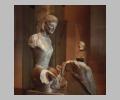
Composite of Rampin Rider (Louvre): original head with cast of body
| Title: | Rampin Rider |
| Context: | From Athens, Acropolis |
| Summary: | Nude male rider on horse, one of a pair |
| Object Function: | Victory? |
| Material: | Marble |
| Sculpture Type: | Free-standing statue |
| Category: | Separated fragments |
| Style: | High Archaic |
| Technique: | In-the-round |
| Original or Copy: | Original |
| Date: | ca. 550 BC - ca. 540 BC |
| Scale: | Under life-size |
| Region: | Attica |
| Period: | High Archaic |
Subject Description:
Bearded nude horseman on his mount, the earliest preserved of the equestrian statues. Other fragments suggest this is one of a pair, a compositional group. The heads of the horses were apparently turned inward; those of the riders outward. His name derives from the Rampin collection to which the head once belonged. At least eight equestrian groups have been found on the Acropolis. The identification of these figures remains open to question. Because the Rampin Rider wears a wreath, he may represent a victor in one of the Games (if his wreath is of celery, as some believe, the Isthmian or Nemean Games; if of oak, as others think, its symbolism may be more general). The number of these groups may support their identification as victory monuments. Historical figures have also been proposed, e.g. the sons of Peisistratos. As Ridgway notes, however, at this period nudity may still suggest a mythic or at least heroic presence. The Dioskouroi have been suggested. Ridgway points out that in vase painting the Dioskouroi occasionally wear wreaths and are sometimes bearded.
Form & Style:
The composition of such a group was itself an ambitious undertaking for the period. Both the technical difficulty of supporting the weight in marble of a horse and rider on four slim legs (accomplished with the aid of a support under the belly of the horse) and the aesthetic problem of producing a convincing view both frontally and in profile was undoubtedly a great challenge. The head of the rider is among the more advanced elements of the group and helps to date it to the middle of the century. It is often compared with the head of Zeus in the Introduction Pediment from the Acropolis. The interest in the structure of the face and the elaborate detailing of the hair and beard is partially a result of the Attic sculptor's personal style and partly characteristic of the time. The torso of the rider received less attention and is much flatter in its treatment. Based on the perceived style of this work, a small group of other works have been attributed to this sculptor. Because we do not know his name, he is usually referred to as the Rampin Master.
Condition: Fragmentary
Condition Description: Sculpture preserves rider from hips up, missing parts of face and arms below shoulders, as well as some of the horse's neck and mane. See descriptions of pieces in Paris (
Material Description:
Island Marble
Sources Used:
See sources for individual pieces in Paris (